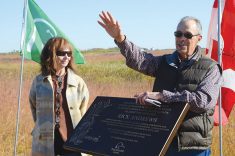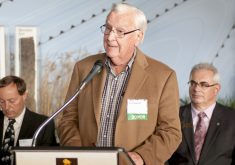Paul Hanley, along with a team with ties to the University of Manitoba, wants to tell you a story about a more just, sustainable agri-food system, one he envisions transforming the Prairies by 2050.
In it, food production systems are developed with an eye to reducing climate change impacts on agriculture. They incorporate Indigenous perspectives on natural balance and interconnection. More effort is given to restoration and conservation of landscapes like grasslands, parklands, bodies of water and riparian zones. Farm practices work towards sequestering carbon and increasing biodiversity.
Farming and environmental industries expand, making rural communities more viable again. At the same time, urban agriculture also becomes more prevalent, eliminating “food deserts,” and organic waste from urban areas becomes fertilizer for farms.

“It is 2050,” Hanley writes in the group’s vision statement, a document part current science and part fictional future. “We are high above Treaty Four territory, the heart of the Northern Plains.
“Today, from our vantage, the dominant impression is of the subtle, endlessly varied, and fluid contours of the prairie agri-biome,” the veteran agriculture and environment writer goes on. “Prominent now are the swales, creeks, and sloughs; the expanses of native grasslands and aspen bluffs, linked by green corridors; the tree-surrounded fields tracing landforms; the well-treed villages… While the iconic grain elevators that once marked each Prairie town are gone, in several places, bison herds have returned.”
The vision statement, informed by a team that includes, among others, University of Manitoba natural systems agriculture professor, Martin Entz, economist Mark Aielski, conservationist Trevor Herriot and Philip Brass, a practitioner of traditional Cree land-based skills, is the foundation of the Kwayeskastasowin Wahkohtowin project.
Read Also

What I learned about Manitoba eggs
Manitoba-laid eggs provide good, locally produced nutrition while supporting local farmers and the Canadian agriculture industry.
The project was chosen out of about 1,300 applicants as a top 10 finalist for the Rockefeller Foundation’s Food System Vision Prize this year.
Why it matters: The group now enters an “accelerator phase,” to refine and look for ways to realize its vision, which is heavy on sustainable ag practices.
Change to what?
Kwayeskastasowin Wahkohtowin is a blend of two Cree words denoting the kinship of people and all parts of the natural world, and the willingness to set things right between Indigenous and non-Indigenous people and the land.
It encompasses six categories — environment, diets, economics, culture, technology and policy — and is set in Treaty Four territory, which includes southern Saskatchewan and parts of Manitoba and Alberta.
“This biome is considered among the most altered in the world,” writes Hanley — pointing to the landscape’s shift from grassland to largely monoculture, export-based agriculture.
Regenerative agriculture — an umbrella term for practices that seek to regenerate soil health like reduced tillage or no till, rotational grazing or perennial cropping — is a key portion of the group’s future. Better knowledge and technology allow farmers to increase soil quality, thereby reducing the effects of drought and flood. Farms are more resilient.
The vision also includes a strong component of cultural transformation around food and agriculture. Traditional Indigenous foods and medicines are more available, and “country foods” like wild game, saskatoons and chokecherries are also valued.
“Food sharing is a universal medium for expressing fellowship; it embodies values of hospitality, duty, giving, sacrifice, and compassion,” Hanley writes.
Why change?
Hanley and company’s 2050 comes about after climate change and other catastrophic forces (such as today’s COVID-19 pandemic) make current global trade levels untenable. Energy and transportation costs are too high and a decreased population reduces demand for Canadian commodities.
As a result, the statement predicts, countries focus on producing food for local or regional markets.

The deterioration of climate and ecosystems, and the associated impact on communities, leads to efforts to restore ecological systems, including regenerative agriculture.
Hanley argues that there are already cracks in Canada’s agri-food system starting to show. The group argues that climate change has already translated to farms absorbing the impact of more extreme weather, while policies and technology meant to solve the issues often involve, “doing more of the same thing that created the problem.”
Current agri-food supply has, “become highly dependent on increasingly intensive external inputs,” he writes. “Gross income from farms is largely transferred to the suppliers of these inputs, while most net farm income comes from government supports and off-farm income. Production costs are high and commodity prices low, making the profit margin per unit of production so small that farmers rely on high volume to generate sufficient income.”
Small farms, meanwhile, have all but disappeared and the farming population is aging. According to the last census of agriculture in 2016, the average farm in Manitoba grew 5.1 per cent between 2011 and 2016, while the number of farms with more than $250,000 in gross farm receipts grew by over 14 per cent, and represented almost 35 per cent of the province’s farm operations.
Diets, Hanley argued, are also poor, pointing to the proportion of processed foods in the average meal plan and rates of chronic illness, something Indigenous populations suffer at even higher rates.
According to 2019 data from Statistics Canada, about 27.7 per cent of adults in Canada were obese, compared to 26.1 per cent in 2015, and 35.8 per cent were overweight (actually the same as in 2015, and down from 36.3 per cent in 2018).
How possible is it?
While the vision portrays something far from today’s reality, Hanley told the Co-operator it might seem more likely if compared to the many agricultural shifts of the past 100 years.
“There’s been mechanization; there’s been farm electrification; there’s been the adoption of agricultural chemicals; there’s been transition to more of a no-till approach,” he said. “There’s been really a lot of radical changes in the system over the last 100 years.”
Hanley noted what he says is a consciousness building on the need to address climate change and environmental issues through how we farm. Consumer interest in locally grown food and knowing where food comes from has also grown. Urban farming, community gardens, farmers’ markets and school gardens have largely popped up in the last 25 to 30 years, he said.
Better policy could have brought about even more progress, Martin Entz told the Co-operator while touring a 29-year-old organic cropping study near Glenlea.
“The amount of research investment in this type of agriculture has been almost zero,” he said.
When he began the study, the University of Manitoba wasn’t overly excited about it, according to Entz. He established it because, “I believe in it, and I’m stubborn, and I have academic freedom,” he said.
Lately, academia has become much more interested.
“What is possible if we actually invest more in farmer education, agronomist education and research?” he asked.
“Will we achieve it or not? I don’t know,” said Hanley. “World peace — are we ever going to achieve world peace? I don’t know. But should we fight for world peace? Yes… Will we stop climate change? I don’t know. But should we try? Yes.
“I think this kind of visionary approach has a role to play and let’s try to make it happen. Will we? I don’t know, but don’t you think we should try?” he said.
In September, award finalists begin a three-month “accelerator phase,” during which they’ll work to refine visions further, look for ways to implement the visions and engage stakeholders.
Each finalist has the chance to win a “Top Visionary” prize of $200,000, to be announced in December.




















